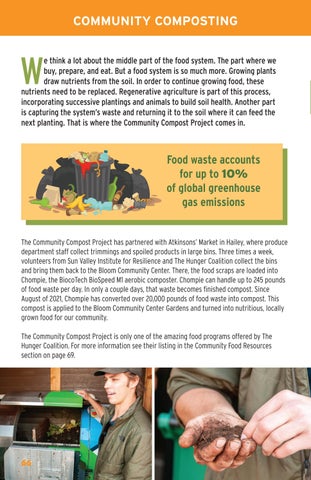COMMUNITY COMPOSTING
W
e think a lot about the middle part of the food system. The part where we buy, prepare, and eat. But a food system is so much more. Growing plants draw nutrients from the soil. In order to continue growing food, these nutrients need to be replaced. Regenerative agriculture is part of this process, incorporating successive plantings and animals to build soil health. Another part is capturing the system’s waste and returning it to the soil where it can feed the next planting. That is where the Community Compost Project comes in.
Food waste accounts for up to 10% of global greenhouse gas emissions The Community Compost Project has partnered with Atkinsons’ Market in Hailey, where produce department staff collect trimmings and spoiled products in large bins. Three times a week, volunteers from Sun Valley Institute for Resilience and The Hunger Coalition collect the bins and bring them back to the Bloom Community Center. There, the food scraps are loaded into Chompie, the BiocoTech BioSpeed M1 aerobic composter. Chompie can handle up to 245 pounds of food waste per day. In only a couple days, that waste becomes finished compost. Since August of 2021, Chompie has converted over 20,000 pounds of food waste into compost. This compost is applied to the Bloom Community Center Gardens and turned into nutritious, locally grown food for our community. The Community Compost Project is only one of the amazing food programs offered by The Hunger Coalition. For more information see their listing in the Community Food Resources section on page 69.
66















